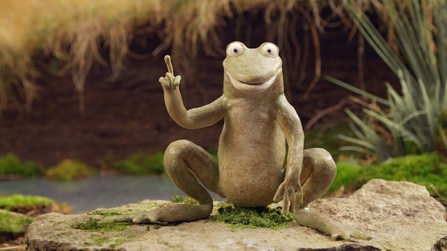
Pete the Frog is just one of the animated characters in the new films about Natural Flood Management © Environment Agency/Cumbria Wildlife Trust

Pete the Frog is just one of the animated characters in the new films about Natural Flood Management © Environment Agency/Cumbria Wildlife Trust
Cumbria Wildlife Trust and partners have created four entertaining and engaging Creature Comforts-style animations to highlight how NFM can help protect Cumbria’s homes, businesses and farms.
Funded by the Environment Agency the short films demonstrate how these techniques decrease flooding downstream, reduce the impact of drought on land, and reduce pollutants in water.
NFM is a catch-all term for a variety of landscaping techniques used to hold water back during flood events, which reduce the impact downstream on buildings and infrastructure such as bridges.
The techniques include restoring peatland, so it soaks up water instead of it draining into rivers; re-meandering rivers to slow down the fast flow of water, which is more likely in straightened rivers; and protecting flood plains from development.
The four ‘stop-motion’ animated films provide a unique opportunity to recreate the varied Cumbrian landscapes and meet several lovable characters who explain the different NFM techniques, bringing the topic to life.
The animations were produced in partnership with the Environment Agency who provided funding, while StudioDOK provided the film making expertise.
The four characters are narrated by ‘local voices’, including David Kennedy and Michael Farrell from the Environment Agency, John Gorst from United Utilities and Abigail Kennedy, a Cumbrian art and photography teacher.
David Harpley, Head of Conservation for Cumbria Wildlife Trust, says: “Cumbria Wildlife Trust works with local landowners and farmers to make Cumbria’s landscape more resilient to the impacts of the climate crisis, such as flooding and drought. Many of the techniques explained in the animations have been used in Cumbria. Restoration of peatland at Tebay Common included the installation of letterbox dams to slow the flow of water, and leaky dams have been installed above a housing estate in Kendal to reduce the impact during a flood event”.
David Kennedy, from the Environment Agency (and the voice of Russell the dog), says: “These brilliant films were created as part of the Cumbria NFM programme to broadly explain what NFM is and how it can benefit farming, communities and the environment. Whilst the films are set in Cumbria, it is important to remember that NFM interventions can be used in any part of the country across a wide variety of landscapes.
“I enjoyed playing the part of Russell the sheep dog and all the narrators have done a fantastic job – their environmental credentials definitely provide a level of authenticity and warmth that shines through.”
The Environment Agency know the devastating impact that flooding can have, which is why protecting people and communities is our top priority. We encourage everyone to sign up for flood warnings by calling Floodline on 0345 988 1188, or by visiting https://flood-warning-information.service.gov.uk/warnings so that they have time to prepare in the event of a flood.